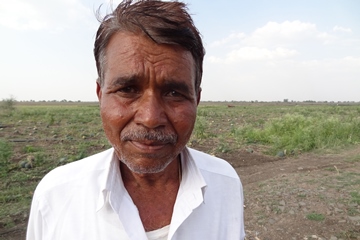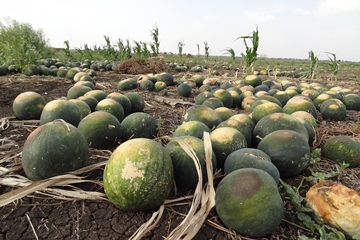Changing Climate Poses a Grave Threat to Indian Farmers
Jaideep Hardikar (India)
Independent Journalist / ALFP 2015 Fellow
The breeze that began to flow around noon had by the evening grown into a heavy storm. Then hail the size of mangoes came pelting down with rain that lasted over 24 hours.
When the weather finally calmed down, 55-year-old Chandrakant Ikhe, a farmer with 16 acres of land, began to count his losses.
“I had no heart to see my farm after this event,” he recounted to me in the summer of 2015, when he was yet to reconcile to his unprecedented loss in those two days.

The ripe, football-sized watermelons lay damaged on his land mauled by the rain of hail. As Ikhe described it then, “It was not just unusual; it was something I had never seen before.”
When I visited his farm a week after this climatic event, the banks of a dry pond provided a stark contrast to the devastation of Ikhe’s land. The extreme event took place in the peak of summer, when you don’t expect rains, and when the entire region is in the grip of a drought. A tank alongside was dry—it bore signs of the rains that had taken place a week ago, but it was sans water. His farm was a picture of devastation. Ikhe was speechless and unable to fathom the turn of events.

Countless watermelons, unfit for consumption, lay strewn all over. Ikhe was not alone in his losses. Tens of watermelon growers in his village and in the vicinity were beset with staggering losses—the fruit that would have hit the markets in a week’s time and fetched them big returns had slipped out of their hands. Such was the shock of a sudden climate event. This was a village in Marathwada, a region known for recurring drought in the otherwise prosperous state of Maharashtra, some 800 miles from Mumbai.
Ikhe’s story of sudden loss is neither isolated nor a rarity. Year upon year, rural India is throwing up stories that tell of aggravated agrarian distress in the face of a fast-changing climate.
Marathwada is a less-rainfall zone. Ikhe’s surroundings were dry as the summer approached its peak. His melons grew on groundwater sucked out of a bore-well. His normal income, he expected, could have been roughly 2 million rupees, or a little over $35,000. It was all gone within two days.
If this was an extreme rainfall event, cut to the other case: Miles away in the southern corner of India is the once-prosperous region of the Cauvery Delta in the state of Tamil Nadu.
Last summer, in 2017, as I traveled in the parched and dry lands of the Delta that was known for its rich paddy and vegetable cultivation until a few decades ago, and for the prosperity that emerged from the cultural civilization blooming along the basin of the Cauvery, a river also known in India as the Ganges of the South, I could not help but wonder if I were witnessing an unprecedented reversal of a civilizational process.
People were migrating away from the river basin villages to the cities in search of water and work.
Thousands of farmers were craving water—and there was none whatsoever anywhere. Paddy, sugar-cane, vegetables, orchards, and fish—everything had perished from the dry and arid Cauvery, her many tributaries, and tens of thousands of canals and lakes that the respective kings had built in the Delta over the last two millennia. Today, the entire region is witnessing recurrent droughts and extreme water scarcity.
A man-made disaster accentuated by the lack of preparation to deal with the climatic changes steadily unfolding in the Cauvery Delta region over the last few decades is now showing up big time—and how. The Delta witnessed over a hundred farmers commit suicide in the 2016–17 agriculture season as they sunk in the quagmire of debt and distress, tens of others died of what the doctors described as shock-deaths—sudden and massive heart attacks resulting out of shock and stress over the phenomenal losses.
Indian peasantry has been in crisis for two decades now—driven by a combination of factors. Among them, the sudden and extreme climatic events and a complete lack of preparedness at both the government level and the level of communities, save some laudable exceptions. We haven’t even begun to understand or quantify the extent of losses the Indian peasantry is suffering every year in the face of extreme events.
But there are enough indications and studies—from the UNFCCC (United Nations Framework Convention on Climate Change) to the studies by the Indian Meteorological Department or the Indian Institute of Tropical Meteorology—that Indian agriculture will be at the receiving end following a rise in temperature and sweeping changes in monsoon patterns.
Studies by the Indian Institute of Tropical Meteorology, Pune, confirm that the southwest monsoon—that actually contributes about 70% of total rains in the country—has decreased across India by 4.7%. The frequency and magnitude of extreme rainfall events (of greater than 10 cm/day) is increasing, while the frequency of moderate events is waning. In their August 2009 report, the IITM researchers said they scanned the daily rainfall data of 165 stations across the region to ascertain their extreme point rainfall events (EPREs)—highest rainfall in 24 hours—and studied whether there was any change in the number and intensity of such events during the past four decades. They discovered the frequency of such events had gone up considerably after 1960, with an alarming rise in the intensity of the rains. They noticed that major cities, hill stations and islands were affected by heavy downpours.
Another study released in 2009 by Purdue University (US), indicated that the summer monsoon could significantly weaken in India by the end of this century.
Researchers from the Centre for Atmospheric Sciences at the Indian Institute of Technology (IIT), Delhi, also found a similar trend. In their analysis of rainfall data for the period 1951–2004, they found that, overall, long rainy spells (more than 2.5 mm of rain daily for more than four consecutive days) decreased over the last 50 years, while short and dry spells (less than 2.5 mm rain daily for a day or so) increased.
Over 60% of Indian agriculture is rain-dependent—and nearly 80% of Indian farmers are marginal or small. In other words, near 500 million people are at the mercy of monsoons to eke a living from the land. The Indian Monsoon is a dynamic system—so when it fluctuates, becomes more uncertain, and behaves like an irate chap, you have a recipe for a sure disaster, if you aren’t ready to combat it.
Another study by the IITM—in which it studied rainfall data of over a hundred years—told us that we are getting the same amount of rain in fewer numbers of days. Heavy rainfall is both damaging to the crop and percolation. The overexploitation of ground water in water-stressed regions is now alarming.
In many ways, Indian farming is cruising through two differing contrasts accentuated by the events that are becoming a new normal in a changing climate: drought and floods go hand in hand here.
Factor this: The year was 2013. Vast stretches of India were in drought—agriculture had suffered; the water table, depleted because of abysmal rainfall and overuse, was crippled. A third of India was officially suffering from drought and biting water scarcity; yet there were regions that reported sudden and inexplicable extreme climatic events during that period resulting in losses of summer crops.
We are seeing both sometimes in the same regions: extreme rainfall, and dry spells. Indian rivers are going dry, as I saw and reported extensively from western and southern India in 2016–17—when three major perennial rivers, the Godavari, the Krishna and the Cauvery, went dry right from their source.
The impact on rural economies thus is unprecedented. A report last year submitted to the Parliament by a Standing Committee on Agriculture outlined several pressing concerns for the country’s farming. It said climate change is telling upon the seed systems, soil, water availability, production processes and almost every sphere of farming. It is impacting incomes and pushing farmers into poverty.
While we know the broad climatic patterns, what we still don’t know is the regional variations of the impact—for that the different states in India have a role to play.
In 2015, the extreme rainfall events in July ravaged 3,000 km of roads in central India, washed away 300-odd small and medium bridges, flattened more than 100,000 houses and destroyed standing crops on 1.5 million hectares while damaging those on another hundreds of thousands of hectares. More than 100 people died in floods and as many by lightning. Nearly 200 farmers committed suicide during that period of losses.
India’s Agriculture Ministry has warned that global warming could decrease the country’s crop output by up to 40% within the century, and the government’s economic survey suggests this would decrease farmers’ already meager incomes by as much as 25%. Unfortunately, this also implies that because of their near complete dependence on a functioning ecological cycle, vulnerable sections such as farmers and coastal communities in countries like India stand completely bulldozed.
Where are the answers? While the State policies are crucial, solutions to the problem are coming in part from communities that are at the receiving end. Across India, traditional seed saver movements are picking up; farmers who have saved traditional varieties of seeds are building networks, effecting crop pattern changes, resorting to diverse strategies including studying the changes and adapting to those. Small and splintered are those efforts but they are crucial. For they show far more resilience.
Take this: In a district of Bhandara in eastern Maharashtra where small and marginal farmers cultivate paddies, a small collective of marginal farmers has identified and developed some 16 local landraces that have shown durability and resistance to monsoonal fluctuations, in both the short and long run.
Across India, many such collectives are being formed; in fact they are mushrooming as a response to the climate change impact. They are yet to be studied; their strategies yet unacknowledged.
The wisdom of local farmers, their close observation of the crops and landraces that have natural adaptation values, is crucial to the sustenance of farm systems in a changing climate, some of those new collective efforts tell us. Tens of such field experiences show that a new approach is needed—one that builds on modern scientific knowledge but also leverages from the indomitable wisdom of the grass-roots practitioners—the peasantry that is fighting the onslaught of markets and climatic aberrations.
The contents of this article reflect solely the opinions of the author.



